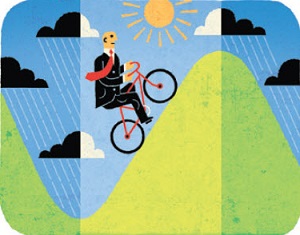It doesn't take an economics Ph.D. to observe that economies experience times when things are generally good and times when things are generally not so good. Expansions in economic activity — the good times — are typically characterized by more jobs, rising incomes, and greater production across a number of industries. Recessions typically include weaker labor markets and lower readings of a wide array of economic indicators.
Economists call these fluctuations "business cycles," and they appear to be inevitable; recessions have occurred every 58 months on average since the end of World War II. The nonprofit National Bureau of Economic Research (NBER) in Cambridge, Mass., tracks the dates of business cycle peaks and troughs. And while not officially dated by the NBER, expansions are sometimes conceptually divided into periods of "recovery" — the time it takes for an economy to achieve the level of activity it had reached before a recession — and times of expansion beyond that level. Recoveries often, though not always, feature rapid growth as economies bounce back to health. Recessions and expansions alike can only be identified several months after they begin.
Why do business cycles occur? Economists think of the economy as always tending to gravitate toward a long-run trend rate of growth. Simultaneously, shocks are continually coming along that bump economic activity above or below that path for a time.
Shocks occur all the time; how do they result in business cycles? Two mainstream, but opposing, schools of thought dominated early research. Models in the Keynesian tradition held that business cycles arise from shocks to aggregate demand, such as a dive in consumer spending (perhaps spurred from shifts in confidence) or government budget tightening. A key element was that prices and wages do not adjust quickly, resulting in painful spells of unemployment and contractions in production. This implied that policymakers can potentially offset recessions with expansionary fiscal or monetary policy.
An alternative framework, in which prices adjust flexibly to changing conditions, suggested that recessions are instead caused by fundamental changes in the economy's ability to produce, such as an oil supply shock or a particularly bad harvest. This "real business cycle" framework suggested that recessions, while painful for affected individuals, are necessary responses to shocks without an obvious role for policymakers to play.
Each approach had its drawbacks. Keynesian models had a limited role for disruptions to supply — which characterized the vast majority of business cycles throughout history. And the real business cycle prediction that monetary policy had no effect on the real economy seemed demonstrably untrue.
Complicating research is that recessions differ dramatically in severity and length, ranging from the three-year, seven-month recession at the start of the Great Depression to the six-month recession of 1980. During the Great Moderation of the mid-1980s through the 2000s, recessions were milder, shorter, and less frequent. Some observers even suggested we had reached the end of business cycles. That proved too optimistic.
The late 1990s saw a synthesis in research that considered different sources of shocks while acknowledging some degree of wage and price stickiness. And since then, research has focused on modeling the frictions in the economy that might make a particular shock more likely to propagate and amplify into an economy-wide downturn.
Financial market frictions, in particular, have been a focus since the 2007-2008 financial crisis. If borrowers are collateral-constrained, for example, to what extent might a decline in housing wealth inhibit the ability of a large number of households to borrow and spend, sparking a deep recession? Financial markets had not always featured prominently in business cycle theory, perhaps because many financial market disturbances — such as the 1987 stock market crash, which had a minimal effect on the economy, and the more recent dot-com bust, which was followed by one of the mildest recessions in modern history — seemed not to affect the overall economy much. The financial crisis differed from these market disturbances in that it took place largely in debt markets. That it was followed by the Great Recession has made many economists rethink the role that debt and deleveraging might play in business cycles.
The expansion following the Great Recession reached 90 months at the end of 2016, one of the longest on record. To some, this raised the question of when the United States might be "due" for another recession. But most economists think that's the wrong question: Though recessions seem to be inevitable, they clearly have no set regularity. In predicting recessions, a good rule of thumb is to worry less about average length of business cycles and more about whether the economy is overheating — and consider that shocks could throw off all predictions.




